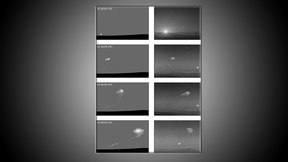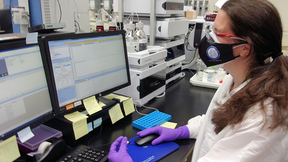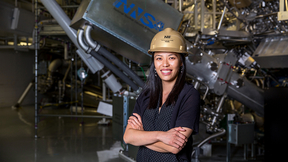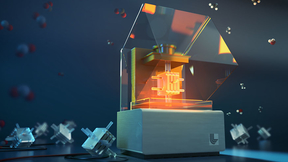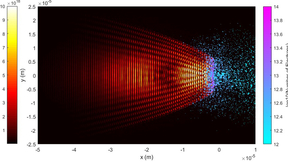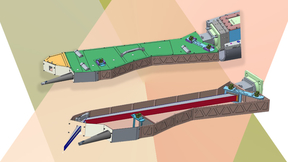Back
Science
Lawrence Livermore team captures data from unarmed Minuteman III test launch
A team from Lawrence Livermore National Laboratory (LLNL) successfully collected data from the recent operational test of an Air Force Global Strike Command unarmed Minuteman III intercontinental ballistic missile (ICBM) launched from Vandenberg Space Force Base. The purpose of the ICBM test launch program is to validate and verify the safety, security, effectiveness and…
LLNL, other Bay Area labs to host webinar about business partnerships, the future of semiconductors
Lawrence Livermore National Laboratory (LLNL) and its three partner national labs in the Bay Area Lab Innovation Networking Center (LINC) will offer a webinar about the future of semiconductors and advanced materials on Wednesday, Aug. 25. The two-hour virtual Zoom webinar, called “Over the Horizon” and set to start at noon Pacific time, is primarily targeted at Bay Area…
National Ignition Facility experiment puts researchers at threshold of fusion ignition
On Aug. 8, 2021, an experiment at Lawrence Livermore National Laboratory’s (LLNL’s) National Ignition Facility (NIF) made a significant step toward ignition, achieving a yield of more than 1.3 megajoules (MJ). This advancement puts researchers at the threshold of fusion ignition, an important goal of the NIF, and opens access to a new experimental regime. The experiment…
Researchers focus on how tantalum behaves at high pressure and temperature
Lawrence Livermore National Laboratory (LLNL) researchers have explored high-pressure behavior of shock-compressed tantalum at the Omega Laser Facility at the University of Rochester’s Laboratory for Laser Energetics (LLE). The work showed tantalum did not follow the predicted phase changes at high pressure and instead maintained the body-centered cubic (BCC) phase until…
Simulating nuclear cloud rise anywhere, anytime
For decades, understanding the behavior of a nuclear mushroom cloud was done with careful analysis of observations made during the testing era. Old photos, outdated film and incomplete weather data made precise calculations difficult. Now, with results published in Atmospheric Environment, Lawrence Livermore National Laboratory (LLNL) scientists are improving our…
LLNL earn 'A' grade in OPCW biomedical proficiency test
It wasn’t an easy road, but Lawrence Livermore National Laboratory (LLNL) Forensic Science Center scientists earned an “A” grade in the Organisation for the Prohibition of Chemical Weapons’ (OPCW) recent biomedical proficiency test. In addition to the usual complexity of the sample preparations and analysis, the Livermore scientists received their proficiency test samples…
Bradley Wallin selected to lead Weapons and Complex Integration
Bradley Wallin has been named Lawrence Livermore National Laboratory’s (LLNL’s) principal associate director (PAD) for Weapons and Complex Integration (WCI), Lab Director Kimberly Budil announced today. In this role, Wallin will lead the Laboratory's nuclear weapons program in its responsibilities to support U.S. strategic deterrence by assuring the safety, security and…
LLNL hosts Test Site Verification Team orientation
Lawrence Livermore National Laboratory (LLNL) hosted an in-person orientation meeting recently for members of the National Nuclear Security Administration’s (NNSA) Test Site Verification Team (TSVT). TSVT is sponsored by NNSA’s Office of Nuclear Verification (ONV) Nuclear Compliance Verification (NCV) Program. The TSVT is led by Kim Knight from LLNL and Emily Schultz…
LLNL physicist Tammy Ma receives excellence in fusion engineering award
The Fusion Power Associates (FPA) Board of Directors has selected Lawrence Livermore National Laboratory (LLNL) experimental physicist Tammy Ma as the recipient of its 2021 Excellence in Fusion Engineering Award. She will receive the award at the Fusion Power Associates 42nd annual meeting Dec. 15-16 in Washington, D.C. Click here for a complete list of previous recipients…
LLNL and KCNSC team up to accelerate design-to-deployment with new polymer production enclave
A polymer production enclave, in partnership with the Kansas City National Security Campus (KCNSC) and Lawrence Livermore National Laboratory (LLNL), is on budget and on schedule to bring modern technology into the Nuclear Security Enterprise. The enclave will enable rapid development of design and production processes of polymer parts for modernization programs. This…
LLNL and KCNSC team up to accelerate design-to-deployment with new polymer production enclave
A polymer production enclave, in partnership with the Kansas City National Security Campus (KCNSC) and Lawrence Livermore National Laboratory (LLNL), is on budget and on schedule to bring modern technology into the Nuclear Security Enterprise. The enclave will enable rapid development of design and production processes of polymer parts for modernization programs. This…
Nuclear forensics international group holds 25th anniversary meeting
Several Lawrence Livermore National Laboratory (LLNL) scientists played key roles in the 25th annual meeting of the Nuclear Forensics International Technical Working Group (ITWG), which met last month. The event, which was conducted in a virtual setting for the first time, was attended by more than 100 experts from 30 countries and highlighted the group’s notable…
LLNL and collaborators improve electrochemical reactor performance through 3D printing
Lawrence Livermore National Laboratory (LLNL) scientists and their collaborators are leveraging the power of 3D printing to improve the performance of electrochemical reactors used to convert carbon dioxide (CO2) to useful energy sources, chemicals and material feedstocks. Working under a cooperative research and development agreement (CRADA) with Stanford University and…
3D hohlraum model assists in indirect-drive implosions at NIF
Scientists from Lawrence Livermore National Laboratory (LLNL) and the Laboratory for Laser Energetics (LLE) have described a simple 3D model in hohlraums and capsules for inertial confinement fusion (ICF) implosions. The model will assist in delivering the required implosion symmetry on layered deuterium-tritium (DT) implosions for ignition. The results of the work remove…
S&TR Magazine Highlights the Inertial Confinement Fusion (ICF) Program
The last U.S. underground nuclear explosive tests, which were key to assessing the design and viability of the country’s nuclear weapons, occurred over 27 years ago. However, the need for deeper understanding of the complex physical processes that drive nuclear weapon performance and for putting stockpile design and assessment on a solid science-based foundation continue…
It’s no drag: New heavy vehicle design increases fuel efficiency, cuts carbon emissions
Reshaping the exterior of heavy vehicles, such as semitrucks, so that they are aerodynamically integrated along their entire length in a smooth, continuous fashion could reduce drag, increase fuel efficiency and cut carbon emissions. Using wind tunnel measurements and computational fluid dynamics simulations, Lawrence Livermore National Laboratory (LLNL) engineers have…
LLNL’s Bill Pitz earns Department of Energy lifetime distinguished achievement award
Lawrence Livermore National Laboratory (LLNL) engineer Bill Pitz has earned a lifetime distinguished achievement award from the Department of Energy’s Vehicle Technologies Office (DOE VTO) for his significant contributions to the field of chemical kinetics. Pitz, along with retiree Charles Westbrook, produced a chemical kinetic study of fuel additives for engine knock in…
Scientists focus on cone targets to enhance temperature of electron beams
Intense short-pulse laser-driven production of bright high-energy sources, such as X-rays, neutrons and protons, has been shown to be an invaluable tool in the study of high energy density science. In an effort to address some of the most challenging applications, such as X-ray radiography of high areal density objects for industrial and national security applications,…
Scientists create a novel instrument to probe thermal states of extreme matter on Earth
Scientists at Lawrence Livermore National Laboratory (LLNL) have collaborated with Princeton Plasma Physics Laboratory (PPPL) to design a novel X-ray crystal spectrometer to provide high-resolution measurements of a challenging feature of high energy density (HED) matter produced by National Ignition Facility (NIF) experiments. The work is featured in a paper in the Review…
New research identifies injury-induced molecular changes in chondrocytes, at single-cell level
Articular cartilage is a connective tissue lining the surfaces of joints. When the cartilage severely wears down, it leads to osteoarthritis (OA), a debilitating disease that affects millions of people globally. The articular cartilage is composed of a dense extracellular matrix (ECM) with a sparse distribution of cells found in healthy cartilage, also known as…






